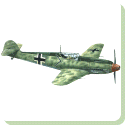 Messerschmitt Bf-109 — The Messerschmitt Bf 109, often called Me 109, was a German World War II fighter aircraft designed by Willy Messerschmitt and Robert Lusser during the early to mid 1930s. It was one of the first true modern fighters of the era, including such features as all-metal monocoque construction, a closed canopy, a retractable landing gear, and was powered by a liquid-cooled, inverted-V12 aero engine.
Messerschmitt Bf-109 — The Messerschmitt Bf 109, often called Me 109, was a German World War II fighter aircraft designed by Willy Messerschmitt and Robert Lusser during the early to mid 1930s. It was one of the first true modern fighters of the era, including such features as all-metal monocoque construction, a closed canopy, a retractable landing gear, and was powered by a liquid-cooled, inverted-V12 aero engine.
The Bf 109 first saw operational service during the Spanish Civil War and was still in service at the dawn of the jet age at the end of World War II, during which time it was the backbone of the Luftwaffe’s fighter force. From the end of 1941 the Bf 109 was supplemented by the Focke-Wulf Fw 190.
Originally conceived as an interceptor, later models were developed to fulfill multiple tasks, serving as bomber escort, fighter bomber, day fighter, night fighter, all weather fighter, ground attack aircraft, and as reconnaissance aircraft. It was supplied to and operated by several states during World War II, and served with several countries for many years after the war. The Bf 109 was the most produced fighter aircraft in history, with a total of 33,984 units produced from 1936 up to April 1945.
The Bf 109 was flown by the three top-scoring German fighter aces of World War II, who claimed 928 victories among them while flying with Jagdgeschwader 52, mainly on the Eastern Front, as well as by Hans-Joachim Marseille, the highest scoring German ace in the North African Campaign. It was also flown by several other successful aces from Germany’s allies, notably Finland, including the highest scoring non-German ace Ilmari Juutilainen, and pilots from Romania, Croatia and Hungary. Through constant development, the Bf 109 remained competitive with the latest Allied fighter aircraft until the end of the war.
Operational History
The first Bf 109As saw service in the Spanish Civil War. By September 1939, the Bf 109 had become the main fighter of the Luftwaffe, replacing the biplane fighters, and was instrumental in gaining air superiority for the Wehrmacht during the Blitzkrieg. During the Battle of Britain it was pressed into the role of an escort fighter, a role for which it was not originally designed, and it was widely employed as a fighter-bomber as well a photo-reconnaissance platform. Despite mixed results over Britain, with the introduction of the improved Bf 109F in the spring of 1941, the type again proved to be an effective fighter during the Invasion of Yugoslavia, the Battle of Crete, Operation Barbarossa, the invasion of the USSR and the Siege of Malta.
In 1942, it began to be partially replaced in Western Europe by a new German fighter, the Focke Wulf Fw 190, but it continued to serve in a multitude of roles on the Eastern Front and in the Defense of the Reich, as well as in the Mediterranean Theatre of Operations and with Erwin Rommel’s Afrikakorps. It was also supplied to several of Germany’s allies, including Finland, Hungary, Romania, Bulgaria, Croatia, and Slovakia.
More aerial kills were made with the Bf 109 than any other aircraft of World War II. One hundred and five (possibly 109) Bf 109 pilots were credited with the destruction of 100 or more enemy aircraft. Thirteen of these men scored more than 200 kills, while two scored more than 300. Altogether this group of pilots were credited with a total of nearly 15,000 kills. Official ace status was granted to any pilot who scored five or more kills. By this standard there were more than 2,500 “Aces” among Luftwaffe fighter pilots in World War II. Against the Soviets, Finnish-flown Bf 109Gs claimed a victory ratio of 25:1.
Bf 109s remained in foreign service for many years after World War II. The Swiss used their Bf 109Gs well into the 1950s. The Finnish Air Force did not retire their Bf 109Gs until March 1954. Romania used its Bf 109s until 1955. The Spanish Hispanos flew even longer. Some were still in service in the late 1960s. They appeared in films (notably The Battle of Britain) playing the role of the Bf 109. Some Hispano airframes were sold to museums which rebuilt them as Bf 109s.
 Kids Portal For Parents India Kids Network
Kids Portal For Parents India Kids Network
